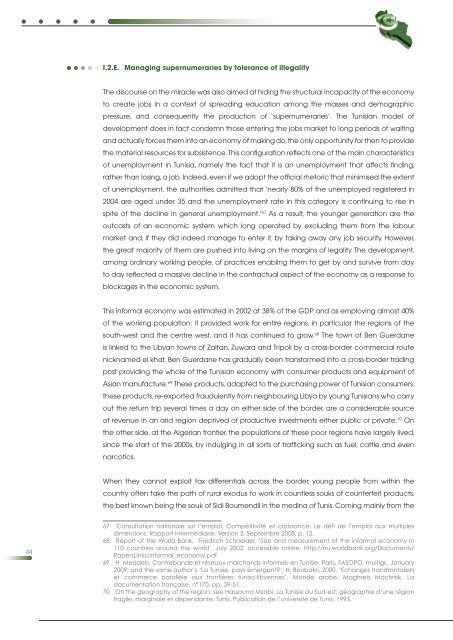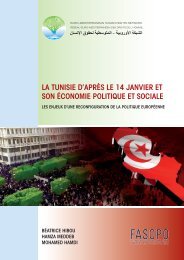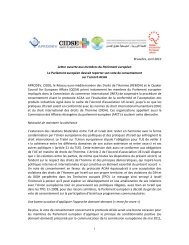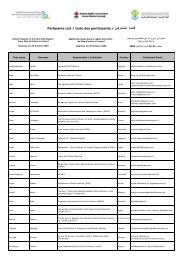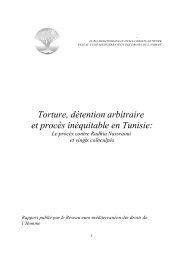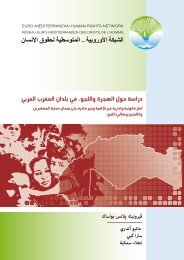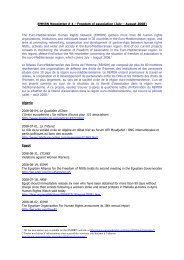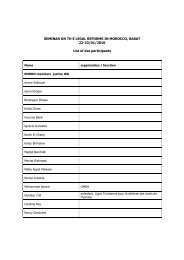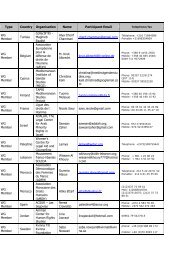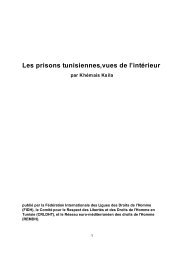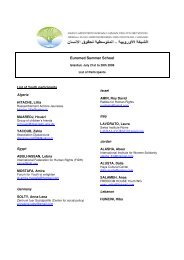tunisia after 14 january and its social and political economy - Refworld
tunisia after 14 january and its social and political economy - Refworld
tunisia after 14 january and its social and political economy - Refworld
You also want an ePaper? Increase the reach of your titles
YUMPU automatically turns print PDFs into web optimized ePapers that Google loves.
I.2.E. Managing supernumeraries by tolerance of illegalityThe discourse on the miracle was also aimed at hiding the structural incapacity of the <strong>economy</strong>to create jobs in a context of spreading education among the masses <strong>and</strong> demographicpressure, <strong>and</strong> consequently the production of ‘supernumeraries’. The Tunisian model ofdevelopment does in fact condemn those entering the jobs market to long periods of waiting<strong>and</strong> actually forces them into an <strong>economy</strong> of making do, the only opportunity for then to providethe material resources for subsistence. This configuration reflects one of the main characteristicsof unemployment in Tunisia, namely the fact that it is an unemployment that affects finding,rather than losing, a job. Indeed, even if we adopt the official rhetoric that minimised the extentof unemployment, the authorities admitted that ‘nearly 80% of the unemployed registered in2004 are aged under 35 <strong>and</strong> the unemployment rate in this category is continuing to rise inspite of the decline in general unemployment.’ 67 As a result, the younger generation are theoutcasts of an economic system which long operated by excluding them from the labourmarket <strong>and</strong>, if they did indeed manage to enter it, by taking away any job security. However,the great majority of them are pushed into living on the margins of legality. The development,among ordinary working people, of practices enabling them to get by <strong>and</strong> survive from dayto day reflected a massive decline in the contractual aspect of the <strong>economy</strong> as a response toblockages in the economic system.This informal <strong>economy</strong> was estimated in 2002 at 38% of the GDP <strong>and</strong> as employing almost 40%of the working population: it provided work for entire regions, in particular the regions of thesouth-west <strong>and</strong> the centre west, <strong>and</strong> it has continued to grow. 68 The town of Ben Guerdaneis linked to the Libyan towns of Zaltan, Zuwara <strong>and</strong> Tripoli by a cross-border commercial routenicknamed el khat. Ben Guerdane has gradually been transformed into a cross-border tradingpost providing the whole of the Tunisian <strong>economy</strong> with consumer products <strong>and</strong> equipment ofAsian manufacture. 69 These products, adapted to the purchasing power of Tunisian consumers,these products, re-exported fraudulently from neighbouring Libya by young Tunisians who carryout the return trip several times a day on either side of the border, are a considerable sourceof revenue in an arid region deprived of productive investments either public or private. 70 Onthe other side, at the Algerian frontier, the populations of these poor regions have largely lived,since the start of the 2000s, by indulging in all sorts of trafficking such as fuel, cattle <strong>and</strong> evennarcotics.When they cannot exploit tax differentials across the border, young people from within thecountry often take the path of rural exodus to work in countless souks of counterfeit products,the best known being the souk of Sidi Boumendil in the medina of Tunis. Coming mainly from the4467 Consultation nationale sur l’emploi, Compétitivité et croissance. Le défi de l’emploi aux multiplesdimensions. Rapport intermédiaire. Version 2. Septembre 2008, p. 12.68 Report of the World Bank, Friedrich Schneider, ‘Size <strong>and</strong> measurement of the informal <strong>economy</strong> in110 countries around the world’, July 2002; accessible online: http://rru.worldbank.org/Documents/PapersLinks/informal_<strong>economy</strong>.pdf69 H. Meddeb, Contreb<strong>and</strong>e et réseaux march<strong>and</strong>s informels en Tunisie, Paris, FASOPO, multigr., January2009; <strong>and</strong> the same author’s ‘La Tunisie, pays émergent?’; H. Boubakri, 2000, ‘Echanges transfrontalierset commerce parallèle aux frontières tuniso-libyennes’, Monde arabe, Maghreb Machrek, Ladocumentation française, n°170, pp. 39-51.70 On the geography of the region, see Hassouna Mzabi, La Tunisie du Sud-est: géographie d’une régionfragile, marginale et dépendante. Tunis, Publication de l’université de Tunis, 1993.


